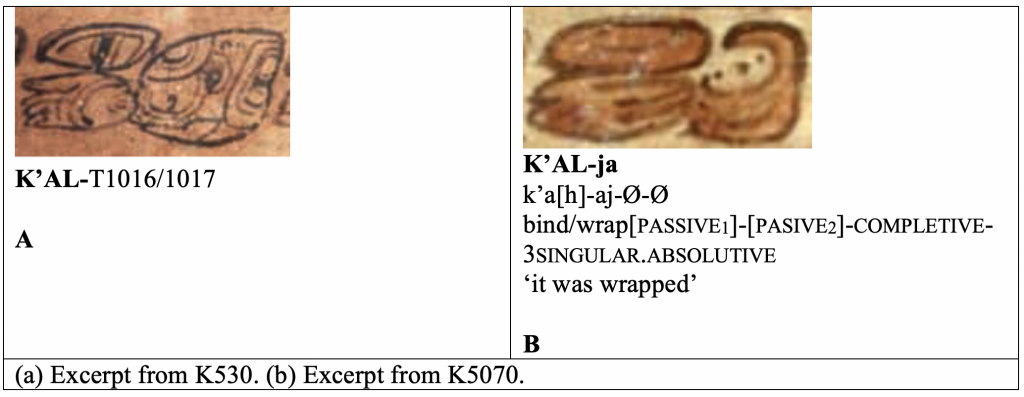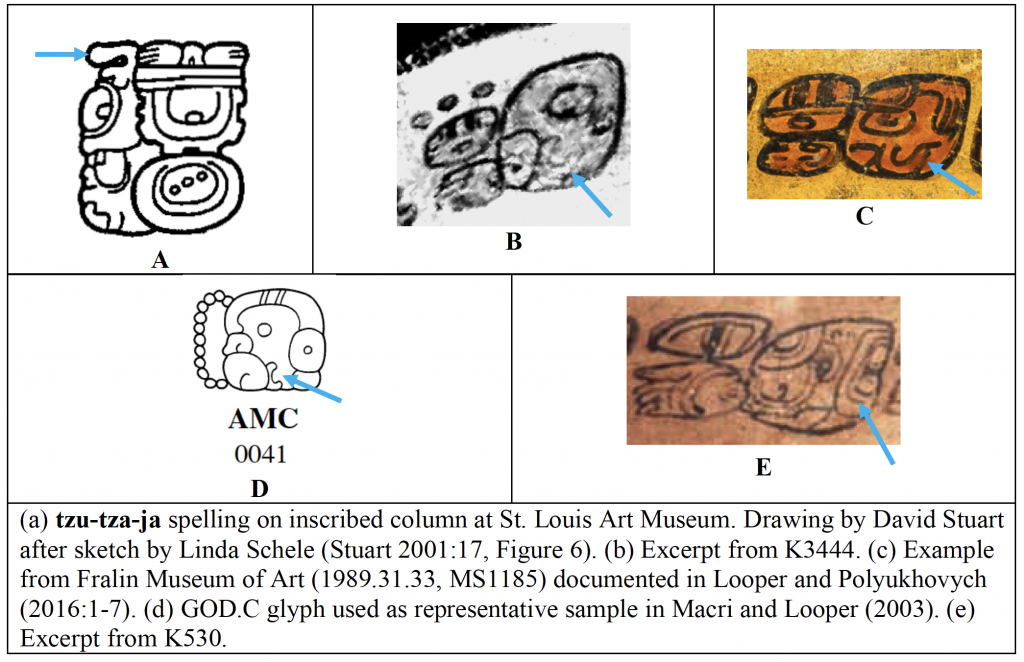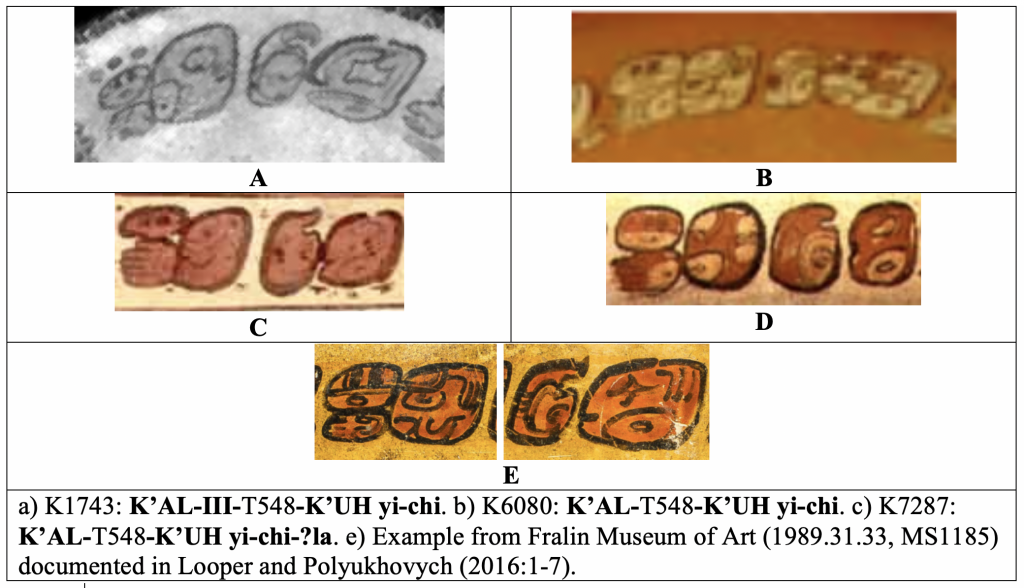The T(1016/)1017 Verbal Glyph of the PSS as k’uh(ul)/ch’uh(ul)-uy(-i) ‘It Became Holy’
David F. Mora-Marín
davidmm@unc.edu
University of North Carolina
Chapel Hill
7/6/2020
Previously, MacLeod (1990:97-98, 508) and Zender (2000:1040) have suggested that T1017 (Thompson 1962) or SSJ (Macri and Looper 2003) bears a syllabographic value ja in the context of certain verbal expressions of the Primary Standard Sequence (PSS) that require the -h-…-aj ‘passive’ bipartite morpheme. More specifically, they have noted its juxtaposition with the FLAT.HAND logogram in the PSS, i.e. K’AL ‘to bind, wrap’, in a number of cases in which T181/ZU1 ja, typically used to partially spell the passive morpheme to yield k’ahl-aj ‘to be wrapped/bound’, is absent, and thus pointing to a possible substitutional, and therefore orthographically equivalent, relationship between T1017 and T181 ja.
Figure 1
As noted by Stuart (2001: 22, footnote 2; 2005:67, footnote 20), T1017 had previously been read by Grube and Schele (1991) as a logogram TZUK ‘partition’; however, Stuart suggests that such value is invalid, and that Grube and Schele instead confused T1017 with “the animated form of the syllable tzu,” namely, T370/559, depicting a gourd with an infixed mirror, originally deciphered by Yuriy Knorozov. Grube and Schele (1991:2) described T1017 as a “pseudo-God C head” or a “God C variant.” I support Stuart’s distinction between the animated version of T370/559 and T1017: although they share the “mirror” element, the former typically exhibits a “veiny” element that tends to fold at the top, seen in Figure 2A, while the latter shows, on occasion, a type of barbel-like element connected to the mouth, as seen in Figures 2B-C. This barbel-like element is characteristic of the God C sign, T1016 (and T41) or AMC, with the logographic value K’UH(UL) for k’uuh > k’uh ‘god’ and k’uh-ul ‘godly/divine’, as seen in Figure 2D, though it is not always present with T1017, as seen in the example on Figure 2E, which actually shows two mirror signs instead of just one.
Figure 2
I follow previous authors (Grube and Schele 1991; Stuart 2001) in their assessment of T1017 as a “God C variant.” While this note does not explain the motivation for the differences in the graphic designs between T1016 and T1017, it is shown below that they may in fact constitute a single sign. But first, I must return to the proposed substitution between T1017 and T181.
The apparent substitution between T1017 and T181 pointed out by MacLeod (1990) and Zender (2000) is striking, and their proposal that such relationship points to a ja syllabographic value for T1017 is no doubt a plausible explanation. Nevertheless, there are two additional facts that must be taken into account.
First, T1017 can occur as a verbal logogram by itself—and in such cases it is typically preceded by T36 K’UH(UL) for k’uuh > k’uh ‘god’ and k’uh-ul ‘godly/divine’. Figure 3A illustrates a rollout photo by Justin Kerr (K3962): the PSS on this vessel is isolated in Figure 3B, and it includes a collocation consisting of the sequence T36.1016/1017 yi-chi, placed between the Initial Sign collation, 7a-INITIAL.SIGN-ya, which begins the clause, and the set of collocations spelled 7u-tz’i-b’a-li 7u-ja-yi yu-k’i-b’i ta tzi-hi-li TE7-le ka for u-tz’ihb’-al u-jay y-uk’ib’ ta tzih-il te7-el ka[kaw] ‘the writing on the vessel, on the drinking cup for raw/fresh te7el ka[kaw]’. (I consider u jay y-uk’ib’ to function as a couplet here). The T36.1016/1017 yi-chi (or T41 yi-chi) collocation in question is shown more clearly in Figure 3C. It fits in the position of the verbal expression whose subject is the phrase ‘the writing on the vessel, on the drinking cup for…’. Another example of the same verbal expression, in a different style and utilizing a different allogram for chi, this time from K1743, is shown in Figure 3D.
Figure 3
Another fact that was not considered by MacLeod (1990) and Zender (2000) is that other known verbal logograms can appear immediately after the K’AL verbal logogram, and in so doing they seem to take the place of the common T181 ja in the K’AL-ja collocation; however, another explanation could be that such cases are the result of abbreviation and condensing of two verbal expressions into a single glyph block. This is seen in Figure 4A, where the GOD.N head glyph occupies the space that would be left for T181 ja in more complete spellings of the K’AL-ja expression, such as that seen in Figure 4B, where the K’AL-ja verbal expression is followed immediately by the GOD.N-yi verbal expression. Thus, the case in Figure 1A could simply be compared to the examples just shown in Figures 4A and 4B and concluded to be a similar instance of a longer phrase involving two verbs in a sequence being graphically compacted within a single glyph block and abbreviated: note that in Figure 4A both K’AL and GOD.N lack the syllabograms used to spell part of the suffixes required, ja and yi, respectively. Similarly, in Figure 1A, K’AL and T1017 also lack the syllabograms—ja and yi again—needed to partially spell the required suffixes, -aj (of -h-…-aj) and -V1y.
Figure 4
Given these facts, it is perhaps more likely that T1017, when present in contexts like that of Figure 1A, is not partially spelling a suffix -aj, in which case it would seem to have an alternative value ja (or jV) not attested in any other context, but is simply a logogram, behaving similarly to the GOD.N logogram just shown above. In addition to the comparability between instances of K’AL-T1017 and cases where two verbal expressions are compacted within a single glyph block (e.g. K’AL-GOD.N, Figure 4A), where neither logogram is given room for the syllabograms needed to partially spell their required suffixes, and the cases where T1017 occupies the position typical of verbal expressions already reviewed above (Figures 3C-D), there is a third line of evidence in favor of a verbal function of T1017: cases where the compacted K’AL-T1017 sequence is itself followed by the syllabographic sequence yi-chi (or yi chi) that typically accompany the verbs in -V1y in the PSS. A set of relevant examples is shown in Figure 5.
Figure 5
It is time to discuss the possible value of the T1017 sign in the context of the PSS. In Figures 3C-D above T1017 was shown to be preceded in two instances by T36. Both T36 and T1016 have the value K’UH(UL) for k’uh ‘god’ or k’uhul ‘godly/holy’. In fact, some epigraphers have suggested the possibility that T36.1016 constitute a single unit that can be abbreviated graphically to either T36 or T1016. (I suspect that the two signs were originally separate allograms with the same value, and that over time they became graphically amalgamated, optionally, because of such shared value. But the two depict different entities: T36 depicts an arrangement of preciosities—jade beads, Spondylus shells—occasionally marked by the sign for K’AN for ‘yellow’ and ‘precious’; T1016 depicts a carved, ritual figurine or statuette.) But in any case, it would seem that when scribes had space to spell the expression in full, they used both, T36.1017 (Figures 3C-D), while in cases where they did not, i.e. cases where the expression was squeezed into the same glyph block as the K’AL logogram, they only used T1017 (Figures 1A, 4A-E). Given this, and pending evidence to the contrary, I favor a reading K’UH (or CH’UH) for T(36.)1016 (or T41) in this context. And given the occasionally explicit use of T17 yi after T41/1016, I assume that it can take the -V1y suffix typically spelled only with T17 yi but occasionally spelled out syllabically as -CV1-yi, where the syllabogram preceding T17 yi almost without exception exhibits vowel harmony with respect to the vowel of the preceding syllable. And in many instances it is followed by T671 chi, likely spelling, together with yi, the enclitic +ich ‘already, really’ (Kaufman, personal communication 2004). Mora-Marín (2007, 2009) has presented evidence in favor of a derivational function of the -V1y suffix so common with verbs in Mayan texts: the suffix, he proposes, derives roots of different types—transitive, intransitive, positional, adjectival—into intransitive verbs. Thus, this constitutes a departure from the analysis of verbs with such suffix as ‘mediopassives’, initially suggested by MacLeod (1990), which was further elaborated by Houston et al. (2000). Instead, Mora-Marín (2007, 2009) has defined this suffix as ‘inchoative (to become X)’ or ‘versive (to begin to become X)’; Mora-Marín (2007) uses the more general label ‘ingressive’, for derived intransitives that focus on the beginning of an action/event. In Mayan languages, inchoatives/versives/ingressives can be applied to a variety of roots, whereas mediopassivization typically applies only to root transitives. Classic Mayan texts, Mora-Marín (2007:5, 2009:138-145) has shown, are characterized by the use of the -V1y suffix with nouns, adjectives, intransitive roots, transitive roots, and positional roots alike.
Returning to the logogram’s value, and the value of the whole verbal expression, Kaufman with Justeson (2003:458-459) reconstruct Proto-Mayan *k’uuh ‘god’ as a noun, and the Greater Lowland Mayan term *k’uh.ul ‘divine’ as an adjective. Since inchoatives, versives, ingressives can be derived from either nouns or adjectives (or transitives or intransitives or positioanls), we may entertain both k’uuh-uy and k’uhul-uy (or ch’uuh-uy and ch’uhul-uy). Either way, it is likely the meaning was equivalent, k’uuh-uy or k’uhul-uy ‘to become holy’. Thus, T1016 K’UH for k’uuh > k’uh ‘god’ could be inflected as an inchoative/versive/ingressive verb, and if so, the following reading would be derived: K’UH(UL)-yi-chi for k’uh(ul)-uy-i/Ø-Ø+ich god(ly)-INCHOATIVE-COMPLETIVE-3SINGULAR.ABSOLUTIVE+ALREADY ‘it became holy already/really’, which analyzes -yi-chi as spelling, in part, the enclitic +ich ‘already, really’ (Kaufman, personal communication, 2004). There is evidence for similar expressions in Greater Tzeltalan languages. For example, Polian (2015:174, 176) attests to the expression ch’uhultes ~ ch’ultes (ch’uh-ul-tes) ‘bendecir, santificar (to bless, to sanctify)’ in Tzeltal as a transitive action derived with -tes (< -t ‘transitivizer’ + -es ‘causativizer’). Polian does not document an intranstivized form, but it stands to reason that it would be possible to derive such a form. Interestingly, the object of the transitive action in the two examples provided by Polian in both cases corresponds to a natural entity that is used by humans or an artificial entity built by humans: lok’ib ‘spring’ in the first (xk’otuk xch’uhultesik te lok’ib ha’e ‘they went to bless the spring’), nah ‘house’ in the second (la xch’ultes nah te pagree ‘the priest blessed the house’). Laughlin and Haviland (1988:200) document several relevant expressions in Tzotzil based on ch’uh ‘god’: ch’uiltas (tv) ‘to bless (meal, water), consecrate’; ch’uulib (iv) ‘to become holy’; and ch’uulibtas (tv) ‘to make holy, sanctify’. It is plausible that Classic Mayan scribes could have derived a similar term using the ubiquitous and widely applicable -V1y suffix. This in turn has important implications for the nature of the “dedicatory formula” as the PSS has also been referred to. The proposed verb k’uh(ul)-uy ‘to become holy’ would suggest that crafted objects (jewelry, pots, stelae, temples) were in actuality “blessed.”
Finally, I raise an observation and a hypothesis for future research concerning the difference between the condensed and separated sequences of verbal expressions. All the instances where two verbal glyphs have been compacted into a single glyph block involving the verbal logogram K’AL exhibit the same pattern: the logogram is represented by means of a left hand (showing the back of the hand pointing to the reader’s left); and all the examples also show either a T617 (“mirror”) sign or a T548 (HAB’ for ha7b’ ‘anniversary’) sign atop the hand sign representing K’AL, which I suspect functions as a semantic determinative—to distinguish the reading K’AL from other possible readings of the same design of the FLAT.HAND, such as K’AB’ for k’ab’ ‘hand/arm’ and the syllabographic value mi. In contrast, when the K’AL logogram takes up its own glyph block it typically shows the more characteristic right hand (showing the back of the hand pointing to the reader’s right), as well as a semantic determinative (either T617 or T548 or occasionally T544), and the syllabogram ja, only rarely providing any other syllabograms to more explicitly spell the expression (e.g. k’a or la). This contrastive pattern can be observed in Figure 4 above, as well as in the examples illustrated here showing K’AL and K’UH (T41/1016/1017) within the same glyph block, in Figures 1A and Figures 5A-E. Thus, it would appear that scribes were graphically distinguishing contexts where K’AL was being abbreviated and compacted within a glyph block along with another verbal logogram in a systematic way.
References
Grube, Nikolai, and Linda Schele. 1991. Tzuk in the Classic Maya Inscriptions. Texas Notes on Precolumbian Art, Writing, and Culture, 14. Art Department, University of Texas at Austin.
Houston, Stephen D., John Robertson, and David S. Stuart. 2000. The Language of Classic Maya Inscriptions. Current Anthropology 41:321-356.
Kaufman, Terrence, with John Justeson. 2003. Preliminary Mayan Etymological Dictionary. http://www.famsi.org/reports/01051/index.html.
Laughlin, Robert M., and John B. Haviland. 1988. The Great Tzotzil Dictionary of Santo Domingo Zinacantán. Smithsonian Contributions to Anthropology No. 31. Washington, D.C.: Smithsonian Institution Press.
Looper, Matthew, and Yuriy Polyukhovych. 2016. Five Inscribed El Zotz-Style Vessels in the Fralin Museum of Art. Glyph Dwellers 45. URL: http://glyphdwellers.com/pdf/R45.pdf.
MacLeod, Barbara. 1990. Deciphering the Primary Standard Sequence. Unpublished Ph.D. dissertation. University of Texas at Austin.
Macri, Martha J., and Matthew G. Looper. 2003. The New Catalog of Maya Hieroglyphs, Volume One, The Classic Period Inscriptions. Norman: University of Oklahoma Press.
Mora-Marín, David F. 2007. The Identification of an Ingressive Suffix in Classic Lowland Mayan Texts. In Proceedings of the CILLA III Conference, October 2007, Austin, Texas, edited by Nora England, pp 1-14. Austin: Archive of the Indigenous Languages of Latin America, Linguistics Department, University of Texas. https://ailla.utexas.org/sites/default/files/documents/MoraMarin_CILLA_III.pdf.
—–. 2009. A Test and Falsification of the “Classic Ch’olti’an” Hypothesis: A Study of Three Proto-Ch’olan Markers. International Journal of American Linguistics 75:115-157.
Polian, Gilles. 2015. Diccionario Multidialectal del tseltal. https://tseltaltokal.org/wp-content/uploads/2018/09/Polian_Diccionario-multidialectal-del-tseltal-enero2015-2.pdf.
Stuart, David. 2001. A Reading of the “Completion Hand” as TZUTZ. Research Reports on Ancient Maya Writing 49. Washington, D.C.: Center for Maya Research.
—–. 2005. The Inscriptions from Temple XIX at Palenque: A Commentary. San Francisco: The Pre-Columbian Art Research Institute.
Thompson, Eric J. 1962. A Catalogue of Maya Hieroglyphics. Norman: University of Oklahoma Press.
Zender, Marc. 2000. A Study of Two Uaxactun-Style Tamale Serving Vessels. In The Maya Vase Book, Volume 6, edited by Justin Kerr, pp. 1038-1071. New York: Kerr Associates.




